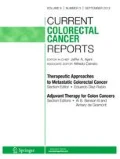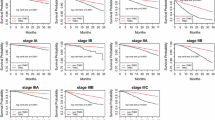Abstract
Colon cancers do not represent a homogeneous entity, and the two main known pathways are the microsatellite instability (MSI) and chromosomal instability pathways. Although statistically significant, the absolute improvement in overall survival with 5-fluorouracil (5-FU) adjuvant chemotherapy in patients with stage II colon cancer is small and does not support the use of adjuvant chemotherapy in all patients. Today, concordant and accumulated results of independent large studies show that microsatellite status is a robust prognostic factor in colon cancer. Moreover, patients with stage II MSI tumors do not benefit from 5-FU adjuvant chemotherapy alone. Therefore, these results do not support the use of fluoropyrimidine adjuvant chemotherapy in patients with MSI stage II colon cancer. Consequently, microsatellite status should be determined before making any decision regarding adjuvant chemotherapy in patients with stage II colon cancer.
Similar content being viewed by others
References
Papers of particular interest, published recently, have been highlighted as: • Of importance•• Of major importance
Ferlay J, Autier P, Boniol M, et al.: Estimates of the cancer incidence and mortality in Europe in 2006. Ann Oncol 2007, 18:581–592.
Gatta G, Capocaccia R, Sant M, et al.: Understanding variations in survival for colorectal cancer in Europe: a EUROCARE high resolution study. Gut 2000, 47:533–538.
Tazi MA, Faivre J, Lejeune C, et al.: Performances du test Hemoccult dans le dépistage des cancers et des adénomes colorectaux. Résultats de cinq campagnes de dépistage en Saône-et-Loire. Gastroenterol Clin Biol 2004, 23:575–580.
Moertel CG, Fleming TR, Macdonald JS, et al.: Levamisole and fluorouracil for adjuvant therapy of resected colon carcinoma. N Engl J Med 1990, 322:352–358.
• André T, Boni C, Navarro M, et al.: Improved overall survival with oxaliplatin, fluorouracil, and leucovorin as adjuvant treatment in stage II or III colon cancer in the MOSAIC trial. J Clin Oncol 2009, 27:3109–3116, This article reports the final results of the MOSAIC study, with a subgroup analysis of patients with stage II colon cancer.
Gill S, Loprinzi CL, Sargent DJ, et al.: Pooled analysis of fluorouracil-based adjuvant therapy for stage II and III colon cancer: who benefits and how much? J Clin Oncol 2004, 22:1797–1806.
•• QUASAR Collaborative Group: Adjuvant versus observation in patients with colorectal cancer: a randomised study. Lancet 2007, 370:2020–2029, This article reports that the use of fluoropyrimidine adjuvant chemotherapy in patients with stage II colon cancer is associated with a 3.6% reduction in the relative risk of death at 5 years.
Weitz J, Koch M, Debus J, et al.: Colorectal cancer. Lancet 2005, 365:153–165.
•• Grady WM, Carethers JM: Genomic and epigenetic instability in colorectal pathogenesis. Gastroenterology 2008, 135:1079–1099, This is a thorough and insightful review that describes the molecular pathways involved in colorectal carcinogenesis.
Haydon AMM, Jass JR: Emerging pathways in colorectal-cancer development. Lancet Oncol 2002, 3:83–88.
Boland CR, Thibodeau SN, Hamilton SR, et al.: A National Cancer Institute workshop on microsatellite instability for cancer detection and familial predisposition: development of international criteria for the determination of microsatellite instability in colorectal cancer. Cancer Res 1998, 58:5248–5257.
Umar A, Boland CR, Terdiman JP, et al.: Revised Bethesda guidelines for hereditary nonpolyposis colorectal cancer (Lynch syndrome) and microsatellite instability. J Natl Cancer Inst 2004, 96:261–268.
Cunningham JM, Christensen ER, Tester DJ, et al.: Hypermethylation of the hMLH1 promoter in colon cancer with microsatellite instability. Cancer Res 1998, 58:3455–3460.
•• Tejpar S, Bosman F, Delorenzi M, et al.: Microsatellite instability (MSI) in stage II and III colon cancer treated with 5FU-LV or 5FU-LV and irinotecan (PETACC 3-EORTC 40993-SAKK 60/00 trial). J Clin Oncol 2009, 27(15S):4001, This large study highlighted MSI phenotype as a major prognostic factor in stage II colon cancer. The abstract and oral presentation from the 2009 American Society of Clinical Oncology meeting were followed by a recent publication showing that MSI phenotype is a prognostic factor in stage II and III colon cancers (Roth AD, Tejpar S, Delorenzi M, et al.: Prognostic role of KRAS and BRAF in stage II and III resected colon cancer: results of the translational study on the PETACC-3, EORTC 40993, SAKK 60-00 trial. J Clin Oncol 2010, 28:466–474).
Barault L, Charon-Barra C, Jooste V, et al.: Hypermethylator phenotype in sporadic colon cancer: study on a population-based series of 582 cases. Cancer Res 2008, 68:8541–8546.
Kohonen-Corish MRJ, Daniel JJ, Chan C, et al.: Low microsatellite instability is associated with poor prognosis in stage C colon cancer. J Clin Oncol 2005, 23:2318–2324.
Halford S, Sasieni P, Rowan A, et al.: Low-level microsatellite instability occurs in most colorectal cancers and is a nonrandomly distributed quantitative trait. Cancer Res 2002, 62:53–57.
Vasen HFA, Watson P, Mecklin JP, Lynch HT: New clinical criteria for hereditary nonpolyposis colorectal cancer (HNPCC, Lynch syndrome) proposed by the International Collaborative Group on HNPCC. Gastroenterology 1999, 116:1453–1456.
Thibodeau SN, French AJ, Cunningham JM, et al.: Microsatellite instability in colorectal cancer: different mutator phenotypes and the principal involvement of hMLH1. Cancer Res 1998, 58:1713–1718.
Ward R, Meagher A, Tomlinson I, et al.: Microsatellite and the clinicopathological features of sporadic colorectal cancer. Gut 2001, 48:821–829.
Young J, Simms LA, Biden KG, et al.: Features of colorectal cancers with high-level microsatellite instability occurring in familial and sporadic settings: parallel pathways of tumorigenesis. Am J Pathol 2001, 159:2107–2116.
Lothe RA, Peltomäki P, Meling GI, et al.: Genomic instability in colorectal cancer: relationship to clinicopathological variables and familial history. Cancer Res 1993, 53:5849–5852.
Lanza G, Gafà R, Santini A, et al.: Immunohistochemical test for MLH1 and MSH2 expression predicts clinical outcome in stage II and III colorectal cancer patients. J Clin Oncol 2006, 24:2359–2367.
Buhard O, Cattaneo F, Wong YF, et al.: Multipopulation analysis of polymorphisms in five mononucleotide repeats used to determine the microsatellite instability status of human tumors. J Clin Oncol 2006, 24:241–251.
Hampel H, Frankel WL, Martin E, et al.: Feasibility of screening for Lynch syndrome among patients with colorectal cancer. J Clin Oncol 2008, 26:5783–5788.
Chapusot C, Martin L, Laurent-Puig P, et al.: What is the best way to assess microsatellite instability status in colorectal cancer ? Am J Surg Pathol 2004, 28:1553–1559.
Ribic CM, Sargent DJ, Moore MJ, et al.: Tumor microsatellite-instability status as a predictor of benefit from fluorouracil-based adjuvant chemotherapy for colon cancer. N Engl J Med 2003, 349:247–257.
Popat S, Hubner R, Houlston RS: Systematic review of microsatellite instability and colorectal prognosis. J Clin Oncol 2005, 23:609–618.
Sinicrope FA, Rego RL, Halling KC, et al.: Prognostic impact of microsatellite instability and DNA ploidy in human colon carcinoma patients. Gastroenterology 2006, 131:729–737.
Sargent DJ, Marsoni S, Thibodeau SN, et al.: Confirmation of deficient mismatch repair (dMMR) as a predictive marker for lack of benefit from 5-FU based chemotherapy in stage II and III colon cancer (CC): a pooled molecular reanalysis of randomized chemotherapy trials. J Clin Oncol 2008, 26(15S):4008.
Parc Y, Gueroult S, Mourra N, et al.: Prognostic significance of microsatellite instability determined by immunohistochemical staining of MSH2 and MLH1 in sporadic T3N0M0 colon cancer. Gut 2004, 53:371–375.
Kim GP, Colangelo LH, Wieand HS, et al.: Prognostic and predictive roles of high-degree microsatellite instability in colon cancer: a National Cancer Institute-National Surgical Adjuvant Breast and Bowel Project Collaborative Study. J Clin Oncol 2007, 25:767–772.
Watanabe T, Wu TT, Catalano PJ, et al.: Molecular predictors of survival after adjuvant chemotherapy for colon cancer. N Engl J Med 2001, 344:1196–1206.
Barratt PL, Seymour MT, Stenning SP, et al.: DNA markers predicting benefit from adjuvant fluorouracil in patients with colon cancer: a molecular study. Lancet 2002, 360:1381–1391.
•• Schwitalle Y, Kloor M, Eiermann S, et al.: Immune response against frameshift-induced neopeptides in HNPCC patients and healthy HNPCC mutations carriers. Gastroenterology 2008, 134:988–997, This article proves that the MSI-induced generation of truncated immunogenic peptides stimulates the antitumor response that probably plays a large role in the better prognosis of patients with MSI tumor.
Arnold CN, Goel A, Bolan CR: Role of hMLH1 promoter hypermethylation in drug resistance to 5-fluorouracil in colorectal cancer cell lines. Int J Cancer 2003, 106:66–73.
Tajima A, Hess MT, Cabrera BL, et al.: The mismatch repair complex hMutS alpha recognizes 5-fluorouracil-modified DNA: implications for chemosensitivity and resistance. Gastroenterology 2004, 127:1678–1684.
Hemminki A, Mecklin JP, Järvinen H, et al.: Microsatellite instability is a favorable prognostic indicator in patients with colorectal cancer receiving chemotherapy. Gastroenterology 2000, 119:921–928.
Des Guetz G, Schischmanoff O, Nicolas P, et al.: Does microsatellite instability predict the efficacy of adjuvant chemotherapy in colorectal cancer? A systematic review with meta-analysis. Eur J Cancer 2009, 45:1890–1896.
Chua W, Goldstein D, Lee CK, et al.: Molecular markers of response and toxicity to FOLFOX chemotherapy in metastatic colorectal cancer. Br J Cancer 2009, 101:998–1004.
• Zaanan A, Cuilliere-Dartigues P, Guilloux A, et al.: Impact of p53 expression and microsatellite instability on stage III colon cancer disease-free survival in patients treated by 5-fluorouracil and leucovorin with or without oxaliplatin. Ann Oncol 2009 Oct 15 (Epub ahead of print), This retrospective study was the first to report that a combination of oxaliplatin and 5-FU improved relapse-free survival compared with 5-FU alone in patients with MSI stage III tumors.
Bertagnolli MM, Niedzwiecki D, Compton CC, et al.: Microsatellite instability predicts improved response to adjuvant therapy with irinotecan, fluorouracil, and leucovorin in stage III colon cancer: cancer and leukemia group B protocol 89803. J Clin Oncol 2009, 27:1814–1821.
Benson AB 3rd, Schrag D, Somerfield MR, et al.: American Society of Clinical Oncology recommendations on adjuvant chemotherapy for stage II colon cancer. J Clin Oncol 2004, 22:3408–3419.
André T, Sargent D, Tabernero J, et al.: Current issues in adjuvant treatment of stage II colon cancer. Ann Surg Oncol 2006, 13:887–898.
Roth AD, Tejpar S, Yan P, et al.: Stage-specific prognostic value of molecular markers in colon cancer: results of the translational study on the PETACC 3-EORTC 40993-SAKK 60-00 trial. J Clin Oncol 2009, 27(15S):4002.
• Kerr D, Gray R, Quirke P, et al.: A quantitative multigene RT-PCR assay for prediction of recurrence in stage II colon cancer: selection of the genes in four large studies and results of the independent, prospectively designed QUASAR validation study. J Clin Oncol 2009, 27(15S):4000, This study reports the promising results of the 12-gene colon cancer recurrence score to identify high-risk stage II colon cancers.
Locker GY, Hamilton S, Harris J, et al.: ASCO 2006 update of recommendations for the use of tumor markers in gastrointestinal cancer. J Clin Oncol 2006, 24:5313–5327.
Gill S, Loprinzi C, Kennecke H, et al.: Analysis of prognostic web-based models for stage II and III colon cancer: a population-based validation of Numeracy and Adjuvant! Online. J Clin Oncol 2009, 27(15S):4044.
•• Pagès F, Kirilovsky A, Mlecnik B, et al.: In situ cytotoxic and memory T cells predict outcome in patients with early-stage colorectal cancer. J Clin Oncol 2009, 27:5944–5951, This study brings to light growing evidence for the prognostic role of the extent of intratumoral immune reaction in colon cancer.
Sakamoto J, Ohashi Y, Hamada C, et al.; Meta-Analysis Group of the Japanese Society for Cancer of the Colon and Rectum; Meta-Analysis Group in Cancer: Efficacy of oral adjuvant therapy after resection of colorectal cancer: 5-year results from three randomized trials. J Clin Oncol 2004, 22:484–492.
Disclosure
Dr. Laurent-Puig has received honoraria from Merck, Amgen, and Myriad Genetics. Dr. de Gramont has served on advisory boards for Sanofi-Aventis, Roche, and Genomic Health. Dr. André has been a consultant to Roche and has received honoraria from Baxter and Sanofi-Aventis. No other potential conflicts of interest relevant to this article were reported.
Author information
Authors and Affiliations
Corresponding author
Rights and permissions
About this article
Cite this article
Bachet, JB., Laurent-Puig, P., de Gramont, A. et al. Microsatellite Status and Adjuvant Chemotherapy in Patients with Stage II Colon Cancer. Curr Colorectal Cancer Rep 6, 148–157 (2010). https://doi.org/10.1007/s11888-010-0054-1
Published:
Issue Date:
DOI: https://doi.org/10.1007/s11888-010-0054-1




